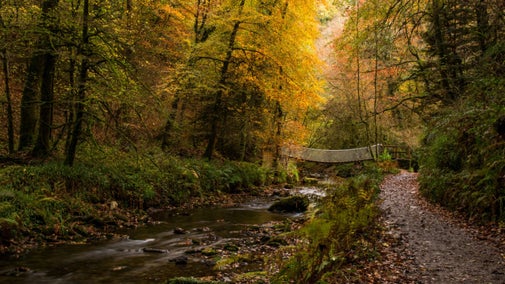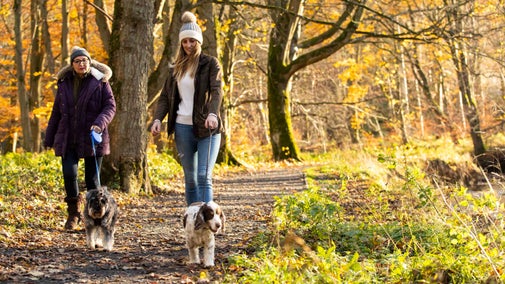
Discover more at Lydford Gorge
Find out when Lydford Gorge is open, how to get here, the things to see and do and more.

The dramatic natural landscape at Lydford Gorge has long influenced human activity and inspired many a tale of myth and legend. This steep-sided river gorge played a key role throughout the Anglo Saxon, Viking and Norman periods. Over time, the area played host to a mint and a castle, and its rugged beauty attracted the most esteemed of 18th-century artists.
Some of the exposed rocks in Lydford Gorge contain fossil bryozoans: tiny filter-feeding sea animals that lived in colonies, much like coral. They are important in helping to age the rocks at Lydford Gorge to the Devonian period.
The reason we can see these rocks on the surface today is that around 300 million years ago the layers were crunched, twisted and folded by enormous movements of the Earth’s crust.
The formation of the gorge and Whitelady Waterfall started around 450,000 years ago when the mighty River Lyd captured the headwaters of the lesser River Burn and, in doing so, was forced to change course. The additional water flowing in the River Lyd helped it erode down through the rock layers.
What was left of the River Burn could not erode the rock as effectively, resulting in a huge difference in height and forming Whitelady Waterfall.
At the end of the last ice age – approximately 11,500 years ago – the meltwater added to the power of the river, creating Lydford Gorge as we see it today.

The River Lyd probably got its name from the Anglo-Saxon word ‘hlyda,’ meaning ‘loud’ – which it certainly is as it rages through the gorge.
Although the exact date of settlement is not known, we do know that there has been human activity next to Lydford Gorge for over 1000 years. It’s easy to see why the site was chosen, with fresh water at hand, woodland to provide firewood and building timber, and the deep gorge carved out by the River Lyd for protection.
In the reign of Alfred the Great, AD 871–899, the natural defences provided by the gorge were reinforced with ramparts that enclosed the whole settlement to help defend against Viking raids.
Sometime after this, a mint was set up, with the earliest coin known to be minted at Lydford dating from AD 973 during the reign of King Edgar. The mint at Lydford operated for around 100 years and in that time produced over 1.5 million silver pennies.
A huge number of these Lydford pennies found their way to Scandinavia as Danegeld: a tax collected to pay off the Vikings and prevent them raiding and pillaging from the sea.
However, in AD 997 the Vikings entered the River Tamar and burned Tavistock Abbey to the ground en route to Lydford. It was probably knowledge of the mint that drew them – Lydford’s defences held though, and they were repelled.
Soon after the Norman conquests of 1066 a castle or ringwork was constructed in the far-west corner of Lydford, right on the edge of Lydford Gorge. It was occupied only briefly and abandoned some time in the next century.

Exploring the gorge, it’s easy to see why there are many stories surrounding it that tend towards the mystical. With a constantly damp atmosphere which sustains luscious plant growth, shiny black rock faces and thunderous water, it can feel like a prehistoric rainforest. That’s before you even start to notice the money logs, pixie doors and quirky wooden faces.
The tale of the ‘Gubbins’, a band of lawless savages whose lair was said to be Lydford Gorge, has been told since at least the 15th century. Other figures of legend, such as the white lady that supposedly haunts the waterfall, are much more ephemeral.
In 1782, artist William Gilpin started discussions around the Picturesque, shifting the nation’s tastes from formal and prescribed landscapes created by man to more rural and rugged landscapes.
Lydford Gorge became the go-to destination for artists searching for a more natural beauty. Lydford was captured in many works of art, including by renowned local artists William Widgery and his son Frederick John Widgery.
Lydford Gorge was bequeathed to the National Trust in 1943 by the Radford family, with the aim of preserving it for the nation and keeping it open for the public to enjoy.
Designated as a Site of Special Scientific Interest (SSSI) in 1952 for its ancient broadleaved woodland, its lichens, liverworts and mosses, and its geological features associated with gorge formation and river capture, the current paths and facilities have been operational since 1969.

Find out when Lydford Gorge is open, how to get here, the things to see and do and more.
Immerse yourself in the wonders of nature and escape the hustle and bustle by enjoying a winter woodland walk to see the towering Whitelady Waterfall at Lydford Gorge.

Discover how to have a dog-friendly visit to Lydford Gorge, including where to walk, what to be aware of and what facilities are available for your four-legged friend

Treat yourself to a hot drink and slice of cake from the waterfall tea-room after hiking to see the Whitelady Waterfall at her wintry best.

At Lydford Gorge the best winter adventure is to see Whitelady Waterfall. After heavy rain it’ll be at its roaring best. Get wellies on to splash your way around some fun ’50 things’ activities.

Find out more about the picturesque aesthetic style and how it became a fashionable choice for wealthy estates in the 18th century. Discover more about the people who influenced the movement.

Learn the ancient origins, traditions and folklore of the summer solstice and discover how midsummer was celebrated in millennia past at some of the places we care for.
